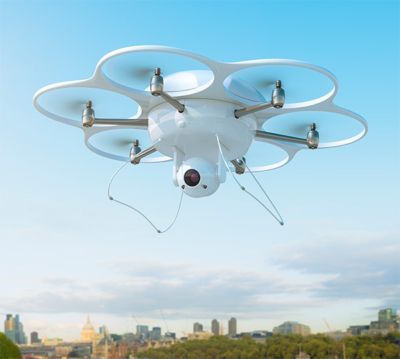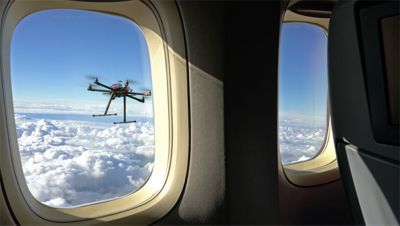-
United States -
United Kingdom -
India -
France -
Deutschland -
Italia -
日本 -
대한민국 -
中国 -
台灣
-
Ansys is committed to setting today's students up for success, by providing free simulation engineering software to students.
-
Ansys is committed to setting today's students up for success, by providing free simulation engineering software to students.
-
Ansys is committed to setting today's students up for success, by providing free simulation engineering software to students.
-
Contact Us -
Careers -
Students and Academic -
For United States and Canada
+1 844.462.6797
Ansys Blog
November 21, 2019
The Challenges to Developing Fully Autonomous Drone Technology
Autonomous drone technology is, to an extent, already available.
To demonstrate, let’s assume the aerospace industry were to adopt the automotive industry’s five levels of autonomy. If so, then we can define:
- Level 0: There is no autonomy.
- Level 1: There are autonomous systems, like altitude control, but the pilot is in control.
- Level 2: There are multiple autonomous systems running simultaneously, but the pilot is in control.
Drones are currently used
for surveys, environmental
studies and reconnaissance
- Level 3: The craft operates autonomously under certain conditions, but a pilot must monitor its progress.
- Level 4: The craft is autonomous in most situations; the pilot can take over but generally doesn’t have to.
- Level 5: The drone is fully autonomous.
Currently, the technology is between Level 3 and Level 4, where the drone can make some decisions, but a certain level of human supervision is necessary.
To make this technology fully autonomous, we have to overcome a few challenges to ensure drones meet local laws, regulations, air/road traffic conditions and safety standards. These challenges include:
- Designing, testing and certifying sensors, radar and cameras able to observe any environment the drone may encounter — particularly in adverse weather
- Developing, testing and certifying software that is functionally safe and secure
- Increasing travel distances and carrying capacity by improving aerodynamics, reducing weight and increasing battery or propulsion system performance
Simulation will play a critical role in addressing these challenges by helping us optimize individual parts and certify whole systems.
What is the Difference between Drones and UAVs?
Drone is a general term, not a technical one. They are generally equated with unmanned aerial vehicles (UAVs).
A UAV flying at sunset
UAVs can be controlled remotely or autonomously. Though they are typically linked to the military, they can fill other applications like aerial photography.
Drones are also associated with smaller aircraft, while larger, self-flying planes — like air-taxis — are generally associated with the term “urban air mobility” vehicles.
When Will We Get Autonomous Drones?
It’s less a question of when we will get autonomous drones and more a question of how autonomous we want them to be. Some of them already have a semblance of autonomy.
Relatively speaking, it’s easy to design a UAV that can safely fly itself high over a city between two pre-defined points, or vertiports. But it’s much harder to design one that can deliver pizza to your front door in an urban environment.
Before drones can deliver your
pizza, we need to develop
new autonomous technologies
The most challenging parts of any flight are the approach, landing and takeoff. In an urban area, the pizza bot will need to perform these actions while avoiding houses, pets, people, clothes lines, weather, birds and other objects in the sky. Until an autonomous craft can perform these actions reliably in an urban setting, prepare to tip the pizza delivery person.
Current drone technology has limitations. For instance, many functions are automated, but an expert is typically supervising the flight, ready to take control. Generally speaking, the technology isn’t ready to:
- Manage complex, unpredictable situations
- Handle adverse weather
- Fly without restrictions in populated areas
We are already starting to see drones being used for remote asset inspections, deliveries to remote areas and emergency use in hazardous situations. In a few years, these and other applications will be commonplace.
Once these applications prove the viability and commercial success of the technology, fully autonomous drones capable of transporting humans will become a reality. In short, it will be some time before we are comfortable letting go of the ultimate safety feature — the remote pilot.
How to Keep Airspace Safe with Fully Autonomous Drones and Aircraft?
This is the challenge we are currently working on. It will require new rules, air/road traffic control systems, predefined routes and enhanced technology to sense, react and avoid obstacles.
First, sensors must be able to clearly sense their environments without being fooled by fog or lighting conditions, such as glare or shadows. These sensors must be affordable and light to maximize the UAV’s carrying capacity or maneuverability.
Radar and transponders will make
the dangerous encounters of drones
and airplanes an unlikely occurrence
The sensors must also be able to view the airspace in every direction around the craft.
We already have the technology needed to avoid air traffic conflicts. Modern airplanes use radar and transponders to sense other planes. These technologies could be added to the UAV system.
Next, software and AI will need to take all the sensor information and make decisions. Simulations will test and train these systems to ensure they will be able to make the safest choice in any conceivable situation.
Finally, fully autonomous UAVs are likely to be electric or hybrid to keep urban emissions down. However, batteries have limited energy densities. Therefore, to get the aircraft to travel farther, carry more and remain efficient, we need better batteries and lighter, highly reliable components.
Simulation is the Key to Autonomous Drone Technology
Autonomous drone technologies will need to be designed, tested and — in the case of artificial intelligence (AI) — trained to ensure public safety.
These tasks would include simulation models of environments, cities and weather conditions that the UAV might face. By tweaking each simulation, we can test, optimize and certify the safety of autonomous technology faster than we ever could using physical prototypes.
Simulations can ensure an autonomous
drone can keep track of all the
air/road traffic it might encounter
Simulation can also be used to:
- Optimize, verify and certify camera, lidar, radar and other sensor performance
- Verify and certify software logic and AI systems
- Test the link between sensors, software and virtual worlds
- Perform functional safety assessments with software, AI and sensors in the loop
- Lightweight components
- Optimize battery, motor and electric propulsion performance
To get insight into the future of air mobility and the challenges created by more autonomous, connected and electric aircraft, view the infographic: Facing the Challenge of Future Air Mobility.
















